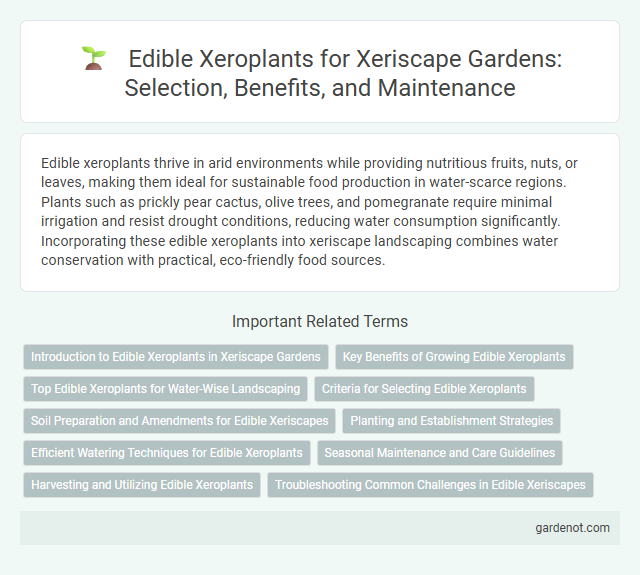Edible xeroplants thrive in arid environments while providing nutritious fruits, nuts, or leaves, making them ideal for sustainable food production in water-scarce regions. Plants such as prickly pear cactus, olive trees, and pomegranate require minimal irrigation and resist drought conditions, reducing water consumption significantly. Incorporating these edible xeroplants into xeriscape landscaping combines water conservation with practical, eco-friendly food sources.
Introduction to Edible Xeroplants in Xeriscape Gardens
Edible xeroplants, such as prickly pear cactus and agave, thrive in xeriscape gardens by requiring minimal water while producing nutritious fruits and leaves. These drought-tolerant species enhance garden sustainability and provide fresh, organic food sources ideal for arid climates. Incorporating edible xeroplants supports water conservation efforts and promotes biodiversity in xeriscape design.
Key Benefits of Growing Edible Xeroplants
Growing edible xeroplants conserves water by thriving in arid conditions with minimal irrigation, making them ideal for sustainable agriculture in drought-prone regions. These plants enhance food security by providing nutrient-dense fruits and vegetables that require fewer resources compared to conventional crops. Xeroplants also promote soil health through deep root systems that prevent erosion and improve soil structure, supporting long-term ecological balance.
Top Edible Xeroplants for Water-Wise Landscaping
Top edible xeroplants for water-wise landscaping include prickly pear cactus, which produces nutritious fruit rich in antioxidants and requires minimal water. Agave species offer sweet sap used for syrup and tequila, thriving in arid soils with exceptional drought tolerance. Other popular options are olive trees and pomegranate shrubs, both yielding valuable harvests while conserving water in xeriscape gardens.
Criteria for Selecting Edible Xeroplants
Edible xeroplants must be selected based on drought tolerance, nutritional value, and soil adaptability to thrive in arid landscapes. Plants like prickly pear cactus and amaranth are ideal due to their low water requirements and high antioxidant content. Soil type, sunlight exposure, and compatibility with local climate also influence the success of edible xeroplant cultivation.
Soil Preparation and Amendments for Edible Xeriscapes
Soil preparation for edible xeriscapes requires well-draining soil enriched with organic matter to retain moisture while preventing waterlogging. Incorporating compost, aged manure, and biochar improves soil fertility and microbial activity, essential for drought-tolerant edible plants like succulents, herbs, and native fruits. Amendments such as gypsum aid in soil structure and calcium availability, optimizing nutrient uptake in arid conditions.
Planting and Establishment Strategies
Successful planting and establishment of edible xeroplants require selecting drought-tolerant species such as prickly pear cactus, agave, and mesquite that thrive in arid conditions. Implementing soil amendments like organic mulch and using efficient drip irrigation systems optimize moisture retention and promote healthy root development. Strategic placement in well-draining soil combined with gradual acclimation to local microclimates enhances plant survival and yield in xeriscape gardens.
Efficient Watering Techniques for Edible Xeroplants
Efficient watering techniques for edible xeroplants include drip irrigation, which delivers water directly to the root zone, minimizing evaporation and runoff. Applying mulch around edible xeroplants helps retain soil moisture, reduces water loss, and suppresses weed growth. Scheduling deep, infrequent watering encourages deep root growth, enhancing drought tolerance and promoting healthier edible xeroplant yields.
Seasonal Maintenance and Care Guidelines
Edible xeroplants such as prickly pear, lavender, and rosemary require seasonal maintenance that includes mulching to retain soil moisture and periodic pruning to promote healthy growth. During dry seasons, deep watering every 2-3 weeks ensures root hydration without overwatering, while fall cleanup involves removing dead foliage to prevent pests. Monitoring soil pH and nutrient balance quarterly supports optimal edible yields and plant vitality.
Harvesting and Utilizing Edible Xeroplants
Harvesting edible xeroplants like prickly pear, mesquite pods, and agave requires timing during peak ripeness to maximize nutritional value and flavor. Proper techniques such as carefully cutting pads or pods without damaging the plant ensure sustainability and continued growth. Utilizing these xeroplants can range from fresh consumption, crafting syrups, jams, or flours, to incorporating them into traditional recipes that highlight their unique, drought-resistant qualities.
Troubleshooting Common Challenges in Edible Xeriscapes
Edible xeroplants often face challenges such as water stress, nutrient deficiencies, and pest infestations that require targeted management strategies. Implementing efficient irrigation methods like drip systems helps reduce water wastage and maintain optimal soil moisture levels for drought-tolerant crops. Regular soil testing and the use of organic mulches improve soil fertility and moisture retention, while natural pest controls minimize damage without harmful chemicals.
Edible xeroplant Infographic

 gardenot.com
gardenot.com